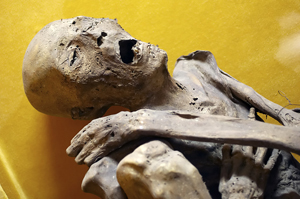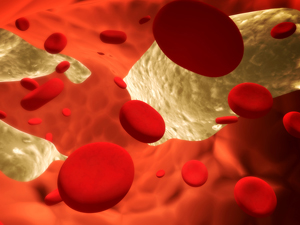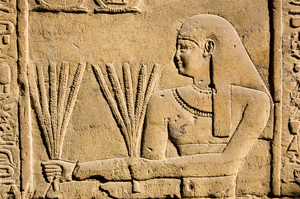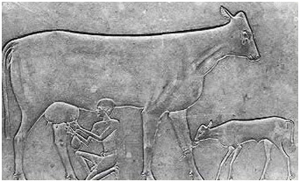Atherosclerosis is thought to be a disease of modern human beings and related to contemporary lifestyles. Its prevalence before the modern era was “suspected” to be much less, but was, in fact, unknown. To resolve this question, a recent study looked back at atherosclerosis across 4000 years of human history by examining mummies from four ancient populations.1 Thompson, Randall C, Allam, Adel H, Lombardi, Guido P, et al. “Atherosclerosis across 4000 years of human history: the Horus study of four ancient populations.” 11/03/2013 The Lancet 0140-6736. http://www.thelancet.com/journals/lancet/article/PIIS0140-6736(13)60598-X/abstract What they found suggests that hardening of the arteries is an old problem–stretching back to the dawn of human history. Perhaps, the study’s authors suggested, we are genetically encoded to have heart disease as we age. We just published a blog on this study, but it only scratched the surface on how to prevent heart disease. There’s a lot more to this topic than meets the eye…or was reported in the press.
Is Heart Disease Genetic?
It’s been generally assumed by most people in the medical field for some time now that atherosclerosis (hardening of the arteries) is caused by smoking, eating fatty foods, high cholesterol levels in the blood, and lack of exercise. In order to once and for all test that theory, the researchers obtained whole body CT scans of 137 mummies from four different geographical regions spanning more than 4000 years. These remains of Individuals from ancient Egypt, ancient Peru, the Ancestral Puebloans of southwest America, and the Unangan of the Aleutian Islands were imaged. Atherosclerosis was regarded as definite if a calcified plaque was seen in the wall of an artery and probable if calcifications were seen along the expected course of an artery.
As just stated, the mummies came from around the world: ancient Egypt, Peru, the southwestern United States, and the Aleutian Islands near Alaska.
- In ancient Egypt, the mummies were deliberately preserved — a practice largely, but not entirely, reserved for royalty.
- In Peru, the southwestern United States, and the Aleutian Islands, the bodies were naturally mummified by dry air and other conditions.
 As it turns out, these ancient peoples did not seem to know how to prevent heart disease. Probable or definite atherosclerosis was noted in 34% of the mummies and in all four geographical populations. That includes: 38% of the 76 ancient Egyptians, 25% of the 51 ancient Peruvians, two of five Ancestral Puebloans, and three of five Unangan hunter gatherers. Specifically, atherosclerosis was present in the aortas (chest and upper abdomen) of 20% of the mummies, in the iliac (lower abdomen) or femoral (thigh) arteries of 18% of the mummies, the popliteal (back of the leg, behind the knee) or tibial (calf) arteries of 18%, the carotid (neck) arteries of 12%, and the coronary arteries of 4% of the mummies. Of the five vascular/arterial beds (minute networks of blood vessels that feed specific area of the body) examined in each mummy, atherosclerosis was present in at least one or two of those beds in 25% of the mummies, in three or four beds in 8%, and in all five vascular beds in 1%. Note: In some cases the mummies’ calcified plaques actually outlasted their arteries.
As it turns out, these ancient peoples did not seem to know how to prevent heart disease. Probable or definite atherosclerosis was noted in 34% of the mummies and in all four geographical populations. That includes: 38% of the 76 ancient Egyptians, 25% of the 51 ancient Peruvians, two of five Ancestral Puebloans, and three of five Unangan hunter gatherers. Specifically, atherosclerosis was present in the aortas (chest and upper abdomen) of 20% of the mummies, in the iliac (lower abdomen) or femoral (thigh) arteries of 18% of the mummies, the popliteal (back of the leg, behind the knee) or tibial (calf) arteries of 18%, the carotid (neck) arteries of 12%, and the coronary arteries of 4% of the mummies. Of the five vascular/arterial beds (minute networks of blood vessels that feed specific area of the body) examined in each mummy, atherosclerosis was present in at least one or two of those beds in 25% of the mummies, in three or four beds in 8%, and in all five vascular beds in 1%. Note: In some cases the mummies’ calcified plaques actually outlasted their arteries.
In summary, more than one-third of the 137 mummies that were CT scanned had calcification in their arteries, suggesting hardening of the arteries. In other words, atherosclerosis was as common in all four preindustrial populations, including pre-agricultural hunter-gatherers as it is today. Although commonly assumed to be a modern disease, the presence of atherosclerosis in pre-modern human beings raises the possibility of a more basic predisposition to the disease. Finding such a high percentage of plaques in the arteries of ancient peoples suggests that it is “either a basic component of aging, or that we are missing something very important that is a cause of atherosclerosis,” says co-author Gregory Thomas, medical director of Memorial Care Heart and Vascular Institute in Long Beach, Calif.
Both male and female mummies had the same amount of plaque. The mummies’ estimated ages ranged from 2½ years old to more than 60 years old, with an average age of 36. Mummies of older people had more atherosclerosis than those of the younger mummies. Curiously, the mean age at death was 43 years for mummies with atherosclerosis versus 32 years for those without. In other words, those with atherosclerosis seemed to live longer. Then again, there was no indication that any of the mummies actually died of heart disease, so it is most likely just a quirk of the numbers resulting from the dangerous lives they lived. And when it came to atherosclerosis in the arterial beds, the mean age at death was more in line with what might be expected. The mean age was 32 for mummies with no atherosclerosis, 42 for those with atherosclerosis in one or two beds, and 44 for those with atherosclerosis in three to five beds. Then again, none of those deaths seemed to be caused by the atherosclerosis. Most likely, they just didn’t live long enough to succumb to it.
Atherosclerosis
Hardening of the arteries or atherosclerosis is a common disorder that often occurs with aging. It occurs when cholesterol, fat, and other substances build up in the walls of arteries and form hard structures called plaques. As plaque builds up along the walls of your arteries, it narrows them and makes them stiffer. These changes make it harder for blood to flow through them. Over time, these plaques can literally block the arteries and cause problems throughout the body–particularly in the heart and brain.
Arterial walls are composed of elastic tissue and smooth muscle. It is their elastic nature and the presence of substantial muscle tissue that allows them to expand and contract as the heart beats. This allows them to even out the increase in pressure caused by each beat. This is one of the primary reasons why hardening of the arteries (atherosclerosis) increases blood pressure. If you pump more fluid through the same sized tube, pressure must increase. On the other hand, if the tube is flexible and can widen, the increase is less.
Another problem is that clots may form in narrowed arteries and completely block the flow of blood. Also pieces of plaque can break off, travel to smaller blood vessels, and completely block them. In a sense, though, it doesn’t matter. Even without clots and breakaway plaque completely blocking arteries, a severe stable blockage can literally starve tissues of blood and oxygen, which can result in damage or tissue death. This, rather than breakaway clots and plaque is the primary cause of heart attack. As the coronary arteries narrow more and more, the lack of blood/oxygen flow literally starves the heart muscle to death. Strokes, on the other hand, are more likely the result of a sudden, complete blockage.
According to a majority in the medical community, after cigarette smoking, a high LDL cholesterol level in the blood is the primary culprit behind atherosclerosis.2 Genest J, Libby P. Lipoprotein disorders and cardiovascular disease. In: Bonow RO, Mann DL, Zipes DP, Libby P, eds. Braunwald’s Heart Disease: A Textbook of Cardiovascular Medicine. 9th ed. Philadelphia, Pa: Saunders Elsevier; 2011. http://www.amazon.com/Braunwalds-Heart-Disease-Cardiovascular-Braunwald/dp/1437703984 As the theory goes, high cholesterol levels are the result of an unhealthy lifestyle — most commonly, eating a diet that is high in fat. Other risk factors are again smoking, plus heavy alcohol use, lack of exercise, and being overweight. According to the medical community, if you want to know how to prevent heart disease, you simply eliminate these risk factors and take statin drugs to reduce cholesterol.
 Many years ago, I proposed that the cholesterol theory of heart disease was largely a myth. At that time I suggested that cholesterol was guilty primarily by being found at the scene of the crime, not because it was actually responsible. Since that time, large segments of the medical community have come to a similar point of view. In fact, more modern theories of coronary heart disease suggest that the primary culprit for hardening of the arteries is systemic inflammation of the arterial system which leads to a buildup of plaque as the body attempts to “plaster over” the damage. For that reason, the medical community now suggests other contributing factors in the development of atherosclerosis such as: diabetes. To that, I would add: the excessive consumption of omega 6 fatty acids as found in many grains, the buildup of circulating immune complexes as the result of the consumption of high allergen foods such as wheat, corn, and dairy that cause the body’s own immune system to attack the arterial walls, and the consumption of a high acid forming diet, which causes a decrease in pH in the muscle tissue surrounding the arteries, which then leads to damage to the arterial walls themselves.
Many years ago, I proposed that the cholesterol theory of heart disease was largely a myth. At that time I suggested that cholesterol was guilty primarily by being found at the scene of the crime, not because it was actually responsible. Since that time, large segments of the medical community have come to a similar point of view. In fact, more modern theories of coronary heart disease suggest that the primary culprit for hardening of the arteries is systemic inflammation of the arterial system which leads to a buildup of plaque as the body attempts to “plaster over” the damage. For that reason, the medical community now suggests other contributing factors in the development of atherosclerosis such as: diabetes. To that, I would add: the excessive consumption of omega 6 fatty acids as found in many grains, the buildup of circulating immune complexes as the result of the consumption of high allergen foods such as wheat, corn, and dairy that cause the body’s own immune system to attack the arterial walls, and the consumption of a high acid forming diet, which causes a decrease in pH in the muscle tissue surrounding the arteries, which then leads to damage to the arterial walls themselves.
According to the medical community, hardening of the arteries cannot be reversed once it has occurred–although they do believe that lifestyle changes and treating high cholesterol levels can prevent or slow the process from becoming worse. Those working in the alternative health community will tell you that they have seen over and over and over again, that plaque buildup and atherosclerosis can indeed be reversed in many cases. And in fact, some in the medical community itself have proven that it can be reversed. (More on that later.)
Mummies Lived a Hard Life
Many people love to idealize the past by claiming that all health problems are the result of our modern lifestyle. In fact, for several decades, even many medical researchers have joined in and stated that the diets of ancient cultures were simply too healthy for those people to develop atherosclerosis. Quite simply, they didn’t eat fast food, trans fatty acids, or foods laced with high fructose corn syrup, hormones, antibiotics, or 100,000 industrial chemicals never before seen in nature. And yes, there is a lot of truth to that. These things do matter, and they really do contribute to much of the catastrophic illness we face these days. But in truth, things are more complex than that. Older is not always better. And it cannot be taken as a blanket statement that all pre-industrial diets were healthier. In fact, the diets and lifestyles of ancient peoples may have been anything but healthy.
Ancient Egypt
Let’s take a quick look at the diet of the ancient Egyptians–the ones who ended up as mummies and the majority of the bodies used in the study. First, it’s always been assumed that the common people ate very clean, healthy diets, whereas royalty ate a richer diet containing more meats and fats and probably more conducive to clogged arteries. Surprise! Egypt was an agricultural society. Their diet was based on cereal grains. The most common foods in ancient Egypt were bread and beer, supplemented by various vegetables such as onions, garlic, leeks, and lettuce. They often ate beans, chick peas, lentils and green peas, just as modern Egyptians do today. Animals were also domesticated, which meant they also consumed eggs and dairy. Fish from the Nile were apparently quite common in the diet, but fresh water fish are not necessarily high in omega-3 fatty acids. And more importantly, the common method of preparation was salting and drying. Meat, on the other hand, was only rarely consumed by commoners. It was definitely more common at meals for the elites. But even then, royalty ate a diet dominated by grains.
 We know this because of what we’ve seen in the teeth of ancient Egyptians, including the mummies of royalty. Wear patterns and dental caries (cavities) reveal a great deal about living and eating habits.3 “Mummies and Disease in Egypt.” University of Illinois at Chicago. (Accessed 17 Mar 2012.) http://www.uic.edu/classes/osci/osci590/6_2Mummies%20Mummies%20and%20Disease%20in%20Egypt.htm In ancient Egypt, the greatest single dental problem was the erosion of teeth. The teeth were rapidly worn down throughout life by the consumption of a coarse grain-based diet. Why so much dental wear? Sand infiltrated their diet, especially in their bread. A single grinding of grain produces coarse flour. Egyptians preferred a more finely ground flour and achieved it by adding a small amount of fine sand to the coarse flour before a second grinding. This indeed made for finer flour, but small amounts of sand in the bread then worked like a grinding stone to steadily wear away the teeth over time. A little bit of grinding, several times a day, year after year, eventually wears down the teeth. And since the mummies of Egyptian royals show severely worn teeth–similar to the mummies of commoners found–we know that breads and pastries were a major part of the royal diet as well.
We know this because of what we’ve seen in the teeth of ancient Egyptians, including the mummies of royalty. Wear patterns and dental caries (cavities) reveal a great deal about living and eating habits.3 “Mummies and Disease in Egypt.” University of Illinois at Chicago. (Accessed 17 Mar 2012.) http://www.uic.edu/classes/osci/osci590/6_2Mummies%20Mummies%20and%20Disease%20in%20Egypt.htm In ancient Egypt, the greatest single dental problem was the erosion of teeth. The teeth were rapidly worn down throughout life by the consumption of a coarse grain-based diet. Why so much dental wear? Sand infiltrated their diet, especially in their bread. A single grinding of grain produces coarse flour. Egyptians preferred a more finely ground flour and achieved it by adding a small amount of fine sand to the coarse flour before a second grinding. This indeed made for finer flour, but small amounts of sand in the bread then worked like a grinding stone to steadily wear away the teeth over time. A little bit of grinding, several times a day, year after year, eventually wears down the teeth. And since the mummies of Egyptian royals show severely worn teeth–similar to the mummies of commoners found–we know that breads and pastries were a major part of the royal diet as well.
Interestingly, dental caries did not seem to be a problem. Theoretically, that is because the sand in the bread literally wore away the sites of pit and fissure cavities–and, of course, because there were no refined carbohydrates in their diet.
But the big issue is that the diet of the ancient Egyptians wasn’t particularly healthy. Specifically, we know the following dietary factors in the ancient Egyptian diet were all likely to contribute to heart disease:
- Their diet was largely grain based.
- Most grains such as wheat and corn are high in omega-6 fatty acids, which promote systemic inflammation.
- Most grains are allergenic to some degree (although, to be sure, modern high gliadin grains are much more problematic). Again, allergens lead to the development of circulating immune complexes (CICs), which lead to inflammation and autoimmune conditions in which the body’s own immune system attacks the arterial walls.
- Grains are acid forming once digested and lead to a drop in pH in body tissue (not the blood) when consumed regularly. This leads to a lower pH in muscle tissue, which means a more acidic environment in the muscles surrounding arteries–again leading to inflammation in the arterial walls and the development of plaque.
- Although we do not know all the fruits that were consumed (figs, grapes, raisins, and pomegranates to name a few), we do know that dates were far and away the most popular fruit–and dates are extremely high in sugar. Combine large consumption of date sugar with a diet based on cereal grains, and you have a high likelihood of early onset diabetes. And we know that if you have diabetes, you are at least twice as likely as someone who does not have diabetes to have heart disease. And people with diabetes also tend to develop heart disease or have strokes at an earlier age than other people.
- Egyptians were familiar with all dairy products. A number of scenes from that time show men carrying what appear to be pots of milk or cream, and butter and cheese have also been depicted. And some studies have pointed to a connection between the consumption of not only dairy fat and heart disease, but also dairy protein and heart disease.4 McLachlan CN. “Beta-casein A1, ischaemic heart disease mortality, and other illnesses.” Med Hypotheses. 2001 Feb;56(2):262-72. http://www.ncbi.nlm.nih.gov/pubmed/11425301 ,5 Boyd Swinburn. “Beta casein A1 and A2 in milk and human health.” New Zealand Food Safety Authority. 132 July 2004. http://www.foodsafety.govt.nz/elibrary/industry/beta_casein-report_reviews.pdf

- And finally, as mentioned earlier, salted fish was likely a significant component of the diet. High salt intake can lead to high blood pressure, which, if high enough and constant enough, can create microscopic tears in the artery walls that then turn into scar tissue. This scar tissue then becomes a trigger point for the formation of plaque and the hardening of the arteries.
The bottom line is that the ancient Egyptian diet, although not modern, was likely not very healthy and would tend to promote systemic inflammation in multiple ways, which could easily lead to the development of plaque and atherosclerosis.
Peru and the Southwest
As the study points out, Peru and the American Southwest were agricultural societies. Heck, maize or corn was the primary foodstuff of the peoples of the Southwest. Like the Egyptians, both of these cultures largely ate cereal based diets. And like the Egyptians, they also domesticated animals, meaning that dairy products and eggs were likely a steady part of their diet. Again, not necessarily overly healthy diets.
Aleutian Islanders
The Unangan of the Aleutian Islands, on the other hand, had a different diet. They were hunter-gatherers who ate a lot of fatty meat and blubber from seals and whales, along with berries, eggs, and seafood. Theoretically, they should have done better in terms of cardiovascular disease, but at least from a very limited sampling did not. On the other hand, there may have been another factor that played havoc with their cardiovascular systems. While the Aleutian Islanders in the study lived in a time before tobacco and industrial smokestacks, they typically cooked over open fires inside their underground dwellings. And while this is true to some degree of all ancient peoples, the Unangan lived in very “sealed” environments. In the Aleutian Islands, people lit and heated their underground homes with lamps made from seal and whale oil, which create high amounts of soot. And unlike their contemporaries who lived in warmer environments with more open spaces and better ventilation, the Aleutian Islanders, breathed deeply of their smoke and soot. And remember, smoking is a primary factor in the development of heart disease. So again, not necessarily such a healthy lifestyle! In more modern but still pre-industrial times, the Inuit who ate a similar diet, but lived in better ventilated dwellings, did not show evidence of heart disease, at least until they switched to a modern diet.
Summary
So while it’s possible that atherosclerosis is part of the natural aging process, genetically programmed into our DNA; it’s also possible that our mummy people, even though they ate pre-industrial diets, were nevertheless exposed to multiple dietary and environmental factors (including a high incidence of chronic inflammatory infections) that led to the development of coronary heart disease. (Note: as the study points out, people with untreated rheumatoid arthritis and lupus tend to develop atherosclerosis 10 to 15 years earlier than normal.) Although we like to romanticize about the good old days–especially as we watch the news–they had their own problems.
How to Prevent Heart Disease
Unfortunately, in America, many people have the wrong idea about the Mediterranean Diet. They think it means lots of pasta and pizza instead of meat, and simple iceberg lettuce salads soaked in cheap Italian dressing instead of vegetables–or perhaps just putting olive oil on everything. We’ll explore the diet in more detail in a moment, but first, let me make mention of the Paleo Diet, which was referenced in the study’s conclusions.
 I do not believe that the “mummy” study invalidates the efficacy of the Paleo Diet in any way. As I have stated in previous reports, I have problems with the amount of meat consumed in the Paleo Diet and the theory behind it, but not the fundamental value of it in terms of how it helps you avoid the foods that are actually harmful to your health. (Note: paleo people, please read the reports through to the end before popping a blood vessel.) Surprisingly, Professor Loren Cordain, the man who originated the Paleo Diet didn’t actually defend those principles when responding to the mummy study.6 Posted by Loren Cordain. “Atherosclerosis in Mummies.” Mar 13, 2013. The Paleo Diet. (Accessed 17 Mar 2013.) http://thepaleodiet.com/uncategorized/atherosclerosis-in-mummies In fact, he accepted the study’s conclusions at face value–merely responding that although the mummies had a high incidence of cardiovascular disease similar to anyone living today, he felt that these ancient peoples would have had a lower incidence of mortality from that disease than we see in modern society. Unfortunately, this is an un-testable theory as all of the ancient mummies died of other causes long before coronary disease could prove fatal.
I do not believe that the “mummy” study invalidates the efficacy of the Paleo Diet in any way. As I have stated in previous reports, I have problems with the amount of meat consumed in the Paleo Diet and the theory behind it, but not the fundamental value of it in terms of how it helps you avoid the foods that are actually harmful to your health. (Note: paleo people, please read the reports through to the end before popping a blood vessel.) Surprisingly, Professor Loren Cordain, the man who originated the Paleo Diet didn’t actually defend those principles when responding to the mummy study.6 Posted by Loren Cordain. “Atherosclerosis in Mummies.” Mar 13, 2013. The Paleo Diet. (Accessed 17 Mar 2013.) http://thepaleodiet.com/uncategorized/atherosclerosis-in-mummies In fact, he accepted the study’s conclusions at face value–merely responding that although the mummies had a high incidence of cardiovascular disease similar to anyone living today, he felt that these ancient peoples would have had a lower incidence of mortality from that disease than we see in modern society. Unfortunately, this is an un-testable theory as all of the ancient mummies died of other causes long before coronary disease could prove fatal.
It is actually quite curious that Professor Cordain did not comment on the fact that none of the peoples evaluated in the study actually ate a true Paleo Diet, except perhaps the Aleutian Islanders, and they have the complicating factor of extremely heavy and chronic smoke inhalation. So there! I’ve done it for him. But as I said a moment ago, although I agree with many aspects of the Paleo Diet, I’m not comfortable with some aspects of it and still prefer a true Mediterranean Diet.
The Mediterranean Diet
The Mediterranean diet is not “actually” the diet of any country or area; instead, it is “inspired” by the traditional dietary patterns of the peoples of southern Italy, Greece, and Spain. Generally it is regarded to center around high consumption of olive oil, legumes, unrefined cereals, fruits, and vegetables, moderate to high consumption of fish, moderate consumption of dairy products (mostly as cheese and yogurt), moderate wine consumption, and low consumption of meat and meat products. I would modify that as follows, however:
- High consumption of vegetables.
- Moderate to high consumption of wild caught fish (if desired…and it’s still available).
- Moderate consumption of organic, free-range chicken or turkey (if desired).
- Moderate consumption of nuts (if not allergic).
- Moderate consumption of fruit.
- Moderate consumption of oils and fats such as:
- Olive oil.
- Walnut oil.
- Avocado oil.
- Coconut oil.
- Organic butter from grass fed cows.
- With supplemental krill oil, squid oil, fish oil, and flax lignans.
- Avoid like the plague all manmade trans fats (natural ones are fine) and all ultra-refined, high omega-6 vegetable oils (the kind that can last on your shelf for years without ever going rancid).
- Low to moderate consumption of organic, free-range meat and meat products (if desired).
- Low consumption of organic, raw dairy products–mostly as yogurt and cheese (if desired).
- Low consumption of legumes– and if you eat them, make sure you soak them before cooking, and then cook them well before eating.
- Low consumption of unrefined, organic grain products. (Avoid the newer strains of non-organic high gliadin wheat.)
- Extremely low (or no) consumption of high glycemic grains, starches, isolated sugars, and any modern, high-gliadin, genetically engineered strains of wheat.
New Mediterranean Diet Study
 The following newly released study on the Mediterranean diet study is certainly of interest especially considering the topic of the day.7 Estruch, Ramón, Ros, Emilio, Salas-Salvadó, Jordi, et al. “Primary Prevention of Cardiovascular Disease with a Mediterranean Diet.” New England Journal of Medicine 25 Feb 2013. NEJMoa1200303. http://www.nejm.org/doi/pdf/10.1056/NEJMoa1200303
The following newly released study on the Mediterranean diet study is certainly of interest especially considering the topic of the day.7 Estruch, Ramón, Ros, Emilio, Salas-Salvadó, Jordi, et al. “Primary Prevention of Cardiovascular Disease with a Mediterranean Diet.” New England Journal of Medicine 25 Feb 2013. NEJMoa1200303. http://www.nejm.org/doi/pdf/10.1056/NEJMoa1200303
The study, published online by The New England Journal of Medicine, was the first major clinical trial to measure the diet’s effect on heart risks. The study concluded that approximately 30 percent of all heart attacks, strokes, and deaths from heart disease could be prevented in people at high risk if they switched to a Mediterranean diet VS eating a low fat diet. The results were so profound that they actually startled the researches, compelling them to end the study early because the results were so clear it was considered unethical to continue.
As the lead researcher, Dr. Ramon Estruch said, “We think the strength of this study comes from the fact that we measured hard outcomes and not just blood pressure or changes in cholesterol levels. We really believe the Mediterranean diet lowers incidence of [heart attack], stroke and cardiovascular deaths.”
Even more surprising is that the diet helped those following it even though they did not lose weight and most of them were already taking statins or blood pressure or diabetes drugs to lower their heart disease risk. This is important because some medical experts had been skeptical that the effect of a Mediterranean diet could be detected, if it existed at all, because so many people are already taking powerful drugs to reduce heart disease risk. And other experts hesitated to recommend the diet to people who already had weight problems, since oils and nuts have a lot of calories.
Two Notes on the Study
First, the diet used in the study actually had people using much more olive oil than I recommend. I don’t think it’s necessary. And besides, focusing on olive oil exclusively denies you the different health benefits found in other fats and oils.
Second, proponents of “very” low-fat diets found the study flawed–claiming that participants in the Mediterranean diet study still had heart attacks and strokes. As they said, “the Mediterranean diet and the horrible control diet were able to create disease in people who otherwise did not have it.” That’s a bit extreme, but to be sure, the very low fat diet was the first to show that heart disease, beyond being stoppable, can also be reversed, without drugs or surgery, through changes in diet and lifestyle. In a randomized trial of 48 heart-disease patients published in 1990 in The Lancet, the Ornish program to reverse heart disease demonstrated an ability to reverse artery blockages after one year–and continued to do so after five years.8 D. Ornish, S.E. Brown, J.H. Billings. “Can lifestyle changes reverse coronary heart disease?” The Lancet, Volume 336, Issue 8708, Pages 129 – 133, 21 July 1990. http://www.thelancet.com/journals/lancet/article/PII0140-6736(90)91656-U/abstract The changes were highly meaningful when compared to a control group, whose condition worsened at both points. In addition, the diet has also been shown to lower blood pressure and decrease both total and LDL cholesterol.
But it’s also been shown to be extremely difficult for most people to stick to. By comparison, following the Mediterranean diet is no more onerous than brushing your teeth at night before bed. In the end, it makes the most sense for the most people. One other thing to keep in mind is that nature doesn’t like extremes. Going to extremes to prevent heart disease may present as many problems as it solves–something the medical community doesn’t like to think about. Holistic medicine deals with the body as a whole; medicine deals with the body, one condition at a time. So what does this have to do with the Ornish diet? Quite simply, forcing fats and cholesterol down to extremely low levels can have unintended consequences. For example, a number have studies have linked very low cholesterol levels to depression and mortality rates that are some 700% higher than normal.9 James M. Greenblatt. “Low Cholesterol and Its Psychological Effects–Low Cholesterol is Linked to Depression, Suicide, and Violence.” June 10, 2011. Psychology Today. (Accessed 18 Mar 2013.) http://www.psychologytoday.com/blog/the-breakthrough-depression-solution/201106/low-cholesterol-and-its-psychological-effects
And it’s not just cholesterol, both omega-3 and omega-6 fatty acids affect mood and behavior. For example, a study published in the Journal of Affective Disorders linked low and abnormal essential fatty acid intake to symptoms of depression.10 “Fish Oil to Treat Depression? Omega-3’s may have an affect on serotonin levels.” WebMD (Accessed 18 Mar 2013.) http://www.webmd.com/depression/features/fish-oil-to-treat-depression Meanwhile, other research has shown that because fatty acids help to insulate nerve cells in the brain, people who are deficient in certain fatty acids may suffer from bipolar disorder,11 Evans SJ, Kamali M, Prossin AR, et al. “Association of plasma omega-3 and omega-6 lipids with burden of disease measures in bipolar subjects.” J Psychiatr Res. 2012 Nov;46(11):1435-41. http://www.ncbi.nlm.nih.gov/pubmed/22884424 schizophrenia,12 Gama CS, Canever L, Panizzutti B, et al. “Effects of omega-3 dietary supplement in prevention of positive, negative and cognitive symptoms: a study in adolescent rats with ketamine-induced model of schizophrenia.” Schizophr Res. 2012 Nov;141(2-3):162-7. http://www.ncbi.nlm.nih.gov/pubmed/22954755 eating disorders,13 Allen KL, Mori TA, Beilin L, Byrne SM, et al. “Dietary intake in population-based adolescents: support for a relationship between eating disorder symptoms, low fatty acid intake and depressive symptoms.” J Hum Nutr Diet. 2012 Dec 6. http://www.ncbi.nlm.nih.gov/pubmed/23216519 and ADHD.14 Richardson AJ, Burton JR, Sewell RP, Spreckelsen TF, Montgomery P. “Docosahexaenoic acid for reading, cognition and behavior in children aged 7-9 years: a randomized, controlled trial (the DOLAB Study).” PLoS One. 2012;7(9):e43909. http://www.ncbi.nlm.nih.gov/pmc/articles/PMC3435388/ And for that matter, even saturated fat is not the villain most people think it is. Can you say coconut oil?
The bottom line is that you may avoid a heart attack on an ultra low-fat diet, but at what cost?
Supplements
In addition to the Mediterranean diet mentioned above, I recommend the following supplements for heart health.
- Magnesium supplementation can change the shape and condition of heart valves.
- The B vitamins can help rebuild the heart.
- CoQ10 can reenergize every single cell in the heart and can literally remold the size and shape of the heart after the onset of congestive heart failure.
- The use of Omega-3 fatty acids can reverse damage caused by NEFAs.
- Proteolytic enzymes can provide nutritional support for your body as it works to clean out the coronary arteries and circulating immune complexes and repair damage to epicardial tissue surrounding the heart.
- The use of heavy metal chelators such as cilantro and chlorella can reduce the risk of an acute coronary event.
- Regular supplementation of a tonic made with cayenne and Hawthorne berry can rebuild the strength of the heart.
- Proper dental care and the use of avocado soy unsaponifiables and proteolytic enzymes can reduce the incidence of periodontal disease, which reduces the chances of an acute coronary event.
- Regular use of immune enhancers and pathogen destroyers decreases the risk of most inflammatory heart disease and the incidence of viral and bacterial infections that can adversely affect the heart.

And regular exercise can strengthen the heart and improve its efficiency even in your eighth and ninth decade of life.
References
| ↑1 | Thompson, Randall C, Allam, Adel H, Lombardi, Guido P, et al. “Atherosclerosis across 4000 years of human history: the Horus study of four ancient populations.” 11/03/2013 The Lancet 0140-6736. http://www.thelancet.com/journals/lancet/article/PIIS0140-6736(13)60598-X/abstract |
|---|---|
| ↑2 | Genest J, Libby P. Lipoprotein disorders and cardiovascular disease. In: Bonow RO, Mann DL, Zipes DP, Libby P, eds. Braunwald’s Heart Disease: A Textbook of Cardiovascular Medicine. 9th ed. Philadelphia, Pa: Saunders Elsevier; 2011. http://www.amazon.com/Braunwalds-Heart-Disease-Cardiovascular-Braunwald/dp/1437703984 |
| ↑3 | “Mummies and Disease in Egypt.” University of Illinois at Chicago. (Accessed 17 Mar 2012.) http://www.uic.edu/classes/osci/osci590/6_2Mummies%20Mummies%20and%20Disease%20in%20Egypt.htm |
| ↑4 | McLachlan CN. “Beta-casein A1, ischaemic heart disease mortality, and other illnesses.” Med Hypotheses. 2001 Feb;56(2):262-72. http://www.ncbi.nlm.nih.gov/pubmed/11425301 |
| ↑5 | Boyd Swinburn. “Beta casein A1 and A2 in milk and human health.” New Zealand Food Safety Authority. 132 July 2004. http://www.foodsafety.govt.nz/elibrary/industry/beta_casein-report_reviews.pdf |
| ↑6 | Posted by Loren Cordain. “Atherosclerosis in Mummies.” Mar 13, 2013. The Paleo Diet. (Accessed 17 Mar 2013.) http://thepaleodiet.com/uncategorized/atherosclerosis-in-mummies |
| ↑7 | Estruch, Ramón, Ros, Emilio, Salas-Salvadó, Jordi, et al. “Primary Prevention of Cardiovascular Disease with a Mediterranean Diet.” New England Journal of Medicine 25 Feb 2013. NEJMoa1200303. http://www.nejm.org/doi/pdf/10.1056/NEJMoa1200303 |
| ↑8 | D. Ornish, S.E. Brown, J.H. Billings. “Can lifestyle changes reverse coronary heart disease?” The Lancet, Volume 336, Issue 8708, Pages 129 – 133, 21 July 1990. http://www.thelancet.com/journals/lancet/article/PII0140-6736(90)91656-U/abstract |
| ↑9 | James M. Greenblatt. “Low Cholesterol and Its Psychological Effects–Low Cholesterol is Linked to Depression, Suicide, and Violence.” June 10, 2011. Psychology Today. (Accessed 18 Mar 2013.) http://www.psychologytoday.com/blog/the-breakthrough-depression-solution/201106/low-cholesterol-and-its-psychological-effects |
| ↑10 | “Fish Oil to Treat Depression? Omega-3’s may have an affect on serotonin levels.” WebMD (Accessed 18 Mar 2013.) http://www.webmd.com/depression/features/fish-oil-to-treat-depression |
| ↑11 | Evans SJ, Kamali M, Prossin AR, et al. “Association of plasma omega-3 and omega-6 lipids with burden of disease measures in bipolar subjects.” J Psychiatr Res. 2012 Nov;46(11):1435-41. http://www.ncbi.nlm.nih.gov/pubmed/22884424 |
| ↑12 | Gama CS, Canever L, Panizzutti B, et al. “Effects of omega-3 dietary supplement in prevention of positive, negative and cognitive symptoms: a study in adolescent rats with ketamine-induced model of schizophrenia.” Schizophr Res. 2012 Nov;141(2-3):162-7. http://www.ncbi.nlm.nih.gov/pubmed/22954755 |
| ↑13 | Allen KL, Mori TA, Beilin L, Byrne SM, et al. “Dietary intake in population-based adolescents: support for a relationship between eating disorder symptoms, low fatty acid intake and depressive symptoms.” J Hum Nutr Diet. 2012 Dec 6. http://www.ncbi.nlm.nih.gov/pubmed/23216519 |
| ↑14 | Richardson AJ, Burton JR, Sewell RP, Spreckelsen TF, Montgomery P. “Docosahexaenoic acid for reading, cognition and behavior in children aged 7-9 years: a randomized, controlled trial (the DOLAB Study).” PLoS One. 2012;7(9):e43909. http://www.ncbi.nlm.nih.gov/pmc/articles/PMC3435388/ |












I am very interested in the
I am very interested in the supplement you mentioned for treating periodontal gum disease…avocado soy unsaponfiables..and proteolitic enzymes. Can you offer me more information as where i find this and also how it works propholatically?? Thanks so much. I believe your research and understanding of the body is brilliant !!
Hi Bonnie,
Hi Bonnie,
All of Jon Barron’s recommended formulas can be found on the “Products” page above. It shows a list of formulas and the companies that sell them. You can also click on each formula to find more information about it. For instance, the proteolytic enzyme formula will link to this article: http://www.jonbarron.org/product/proteolytic-enzyme-formula for more information.
For more information about avocado soy unsaponifiables, click here: http://www.jonbarron.org/article/gum-disease-forest-not-trees
Hi Jon,
Hi Jon,
There is a very good book titled “the Cholesterol lie” original title “Die Cholestorin Luege” don’t know if this book ever was translated into English. Written and Peer reviewed by some of the most prominent researchers!
Author: Prof. Dr Med. Walter Hartenbach
ISBN-13: 978-3776622775
RGDS
Peter
Dear Jon,
Dear Jon,
I wonder whether there might be some specific reason(s) why in your work on CVD there is no reference to the work related to fundamental effect of vitamin C on the integrity of artery wall ( Stone, Williams, McCormick, Pauling, Rath and others …) from which the subsequent “repair processes” unfold. By the way, presence of CVD in mummies is an elegant confirmation of the Pauling /Rath/Stone thesis. We are looking at genetic disease, indeed, BUT it is the genetic disease specific only to humans: LOST CAPACITY to produce vitamin C in our bodies. I have been using this knowledge for some time and measured its effect ( UT of carotid arteries) on my own body to my complete satisfaction.. No more speculations and guessing…
All the best,
Mirek Urednicek
When cholesterol is
When cholesterol is significantly lowered there might not be enough present to be converted to vitamin D in the skin by the UVB rays of the sun. Low levels of vitamin D are associated with a markedly higher risk of heart attack and early death. Vitamin D modulates immun response and inflammation. So one widely overlooked ingredient of the Mediterranean diet could be the abundant sunshine around the Mediterranean sea and the Mediterranean lifestyle using more of it..